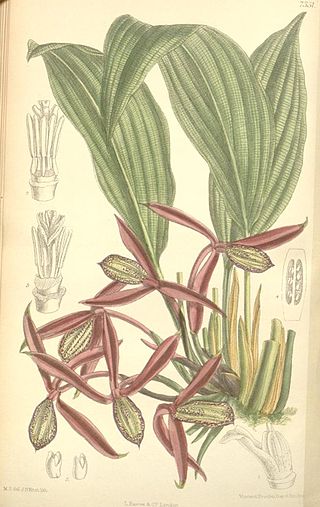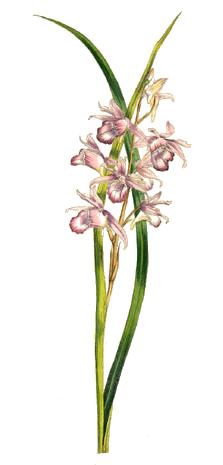
Orchidantha is a genus of flowering plants. In the APG III system, it is placed in the family Lowiaceae, as the sole genus. It includes the plants in the formerly recognised genera Lowia and Protamomum.

Phaius, commonly known as swamp orchids or in Chinese as 鶴頂蘭屬/鹤顶兰属 , is a genus of forty-five species of flowering plants in the orchid family, Orchidaceae. They are evergreen, terrestrial herbs which form clumps with crowded, sometimes stem-like pseudobulbs, large, pleated leaves and relatively large, often colourful flowers. Species in this genus are found in the tropical parts of Africa, Asia, Southeast Asia, New Guinea, Australia, and various islands of the Pacific and Indian Oceans. One species is also naturalized in Hawaii, Florida, and the Caribbean.

Charles Bennet, 4th Earl of Tankerville, styled Lord Ossulston from 1753 to 1767, was a British nobleman, a collector of shells and a famous patron of Surrey cricket in the 1770s. He agreed a set of cricket rules that included the first mention of the Leg before wicket rule.

Agathis borneensis, also known as Borneo kauri, is a species of conifer in the family Araucariaceae.

The North Coast Regional Botanic Garden in Coffs Harbour is a 20 hectare oasis in the heart of Coffs blending a mix of natural coastal forests, planted gardens, discovery walks and picnic areas. On Hardacre Street just one km from the Coffs Harbour CBD on the Mid North Coast region of New South Wales, Australia.

Phaius tankervilleae, commonly known as the greater swamp-orchid, swamp lily, swamp orchid, nun's-hood orchid, nun's orchid, veiled orchid, Lady Tankerville's swamp orchid or 鹤顶兰 , is a species of orchid native to areas from Asia to islands in the Pacific Ocean. It has large, pleated leaves and tall flowering stems bearing up to twenty five white, brown, mauve and yellow flowers. It was named for Lady Tankerville who was the first person to make the orchid flower successfully in England. It was the first tropical orchid to flower in England.

Phaius tankervilleaevar.australis, also known as the common swamp orchid, southern swamp-orchid, swamp lily or island swamp-orchid, is a species of orchid endemic to eastern Australia. It is an evergreen, terrestrial herb with large, crowded pseudobulbs, large pleated leaves and flowers that are reddish brown on the inside and white outside.

Phaius robertsii, commonly known as forest swamp orchid, is a plant in the orchid family and is native to a small area of Tropical North Queensland and to New Caledonia. It is an evergreen, terrestrial herb with above-ground stems, three to five pleated leaves and up to twenty flowers which are yellow on the back and brick-red inside. It grows in wet places in rainforest.

Joinvillea is a flowering plants genus in the family Joinvilleaceae. The family consists of one genus with species distributed from the Malay Peninsula to the Caroline Islands and high islands in the Pacific Ocean. It is evolutionarily significant as a relictual group that is a close relative of grasses. They closely resemble large grass plants, in both general appearance and microanatomy, but possess fleshy fruits.

Phaius philippinensis is a species of orchid in the genus Phaius that was described by N. E. Brown in 1889. It is endemic to the Philippines.

Phaius flavus is a species of orchid in the genus Phaius described by John Lindley in 1831. It is widespread across much of Asia as well as New Guinea, New Caledonia, Samoa and Vanuatu.

Phaius antoninae is a species of orchid in the genus Phaius that was described in 2011 and is native to the Philippines. The type specimen was collected by Antonina G. Balzer in August 1997.
Musa borneensis is a species of wild banana, native to the island of Borneo, in the Malaysian states of Sabah and Sarawak. It is placed in section Callimusa, having a diploid chromosome number of 2n = 20.
Diospyros borneensis is a tree in the family Ebenaceae. It grows up to 20 metres (70 ft) tall. Twigs are reddish brown when young, drying black. Inflorescences bear up to 20 flowers. The fruits are round, drying black, up to 4.2 cm (2 in) in diameter. The tree is named for Borneo. Habitat is forests from sea-level to 1,000 metres (3,300 ft) altitude. D. borneensis is found in Peninsular Thailand, Sumatra, Peninsular Malaysia and Borneo.
Stenomeris is a genus of plants in the family Dioscoreaceae. It has two known species, native to Southeast Asia. Older systems such as that of Hutchinson placed Stenomeris as the type genus of the family Stenomeridaceae, order Dioscoreales.

Phaius tankervilleaevar.bernaysii, also known as the yellow swamp orchid, is a species of orchid endemic to a small area of Queensland. It is an evergreen, terrestrial herb with large, crowded pseudobulbs, large pleated leaves and flowers that are white on the outside and sulfur yellow inside. Apart from flower colour, the species is identical to P. tankervilleae var. bernaysii.
Excoecaria borneensis is a species of flowering plant in the family Euphorbiaceae. It was described in 1914. It is native to Malesia.
Yvonne Chuan Fang Su is a Hong Kong evolutionary biologist who is notable for her co-discovery of Pseuduvaria bruneiensis and Pseuduvaria borneensis. Her doctoral work at the University of Hong Kong focused on the phylogeny of the flowering plant genus Pseuduvaria. Her work as a faculty member at Duke–NUS Medical School focuses on the evolution of viruses.

Cowiea borneensis is a plant in the Rubiaceae family, native to north east Borneo.
Dirk Fok van Slooten was a Dutch botanist. He obtained a doctorate from Utrecht University in 1919. In 1948 he became acting director of the Buitenzorg Botanical Gardens in Java.














